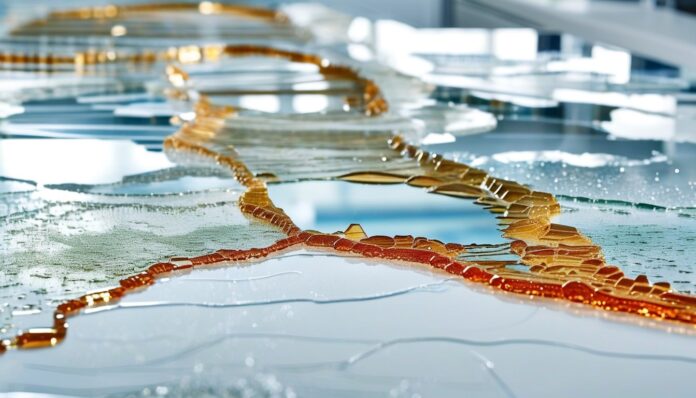Hydrofluoric acid (HF) is a highly corrosive, colorless solution of hydrogen fluoride in water. Despite its hazardous nature, hydrofluoric acid is used in a wide range of industries due to its unique ability to dissolve glass and various materials. Below are its primary uses:
1. Glass Etching and Frosting
One of hydrofluoric acid’s most well-known applications is in glass etching and frosting. Its ability to dissolve silicon compounds allows it to create intricate patterns on glass, which is widely used in decorative glassware and industrial glass parts.
- Glass Etching: Used to etch logos, patterns, and designs on glass products.
- Frosting: Gives glass a translucent, frosted finish often seen in windows, bottles, and lab equipment.
2. Metal Processing and Refining
Hydrofluoric acid is frequently used in metal processing and refining. It plays a crucial role in cleaning and preparing metals such as stainless steel, titanium, and aluminum, particularly by removing oxides and impurities.
- Pickling of Metals: Used to clean stainless steel and remove oxides from metal surfaces.
- Aluminum Production: Assists in refining aluminum by removing impurities during the production process.
3. Petroleum Industry
In the petroleum refining industry, hydrofluoric acid is used as a catalyst in the alkylation process. This process creates high-octane gasoline by combining isobutane with alkenes like butylene.
- Alkylation Catalyst: Improves the quality of gasoline by increasing its octane rating.
4. Electronics and Semiconductor Industry
In the electronics industry, hydrofluoric acid is used to etch silicon wafers during the manufacturing of semiconductors. It’s a key component in the production of microchips and other electronics, helping to create intricate circuits.
- Silicon Wafer Etching: Used to produce semiconductors and microchips by etching precise patterns into silicon wafers.
5. Nuclear Industry
Hydrofluoric acid is also used in the nuclear industry, particularly in the processing of uranium. It plays a role in converting uranium into uranium hexafluoride (UF₆), which is necessary for uranium enrichment and fuel production in nuclear reactors.
- Uranium Processing: Used in converting uranium into uranium hexafluoride for nuclear fuel enrichment.
Interesting Facts about Hydrofluoric Acid
- Extreme Toxicity and Danger: Hydrofluoric acid is one of the most dangerous acids, even in dilute solutions. Unlike other acids, HF not only causes surface burns but also penetrates deeply into tissue and disrupts cellular processes. Even a small exposure can lead to serious health effects, including heart failure, due to fluoride ions binding to calcium in the blood.
- Fatal Industrial Accidents: There have been several fatal industrial accidents involving hydrofluoric acid. In 1987, an explosion at a Marathon Petroleum plant in Texas released hydrofluoric acid, leading to the deaths of workers and prompting increased regulation of HF in the petroleum refining industry.
- Glass Dissolving Abilities: Hydrofluoric acid is unique because it can dissolve glass by reacting with silicon dioxide (SiO₂). This property makes it invaluable for glass etching but also means it must be stored in containers made from materials like polyethylene or Teflon, as glass containers would be destroyed by the acid.
- The 1984 Calvert City Disaster: In 1984, a release of hydrofluoric acid at a manufacturing facility in Calvert City, Kentucky, led to an evacuation of thousands of residents. The incident caused chemical burns and respiratory injuries, highlighting the dangers of accidental HF releases and the need for strict safety protocols.
- Role in Fluorocarbon Phase-Out: Hydrofluoric acid is essential in producing fluorocarbons, which have historically been used in refrigerants and aerosol sprays. However, due to their role in ozone depletion, fluorocarbons have been phased out in favor of more environmentally friendly alternatives. The acid is now used to produce newer, safer refrigerants.
- Environmental Hazards: Hydrofluoric acid spills can have severe environmental consequences, as the acid can rapidly dissolve minerals and harm aquatic life. In 2012, a major spill occurred in South Korea when a tank of HF ruptured, releasing toxic fumes and acid that destroyed crops, killed livestock, and caused numerous health issues in nearby communities.
- Medical Use in Small Quantities: Despite its toxicity, hydrofluoric acid has limited medical uses. For instance, it’s sometimes used in low concentrations to etch the surface of dental crowns or fillings to create a better bond with adhesives. However, strict safety precautions are required due to the acid’s dangerous nature.
- Mystery of the Hydrofluoric Acid Assassination: In 2017, a mysterious death occurred when a scientist working in a research facility in Russia was exposed to hydrofluoric acid. Although initially suspected to be an accident, some conspiracy theories suggested foul play, as HF exposure can be difficult to detect and lethal even in small quantities.
- Historical Use in World War II: During World War II, hydrofluoric acid was used in the Manhattan Project as part of the process to produce enriched uranium for the first atomic bombs. The project used large amounts of HF to create uranium hexafluoride, necessary for isotope separation in nuclear reactors.
- Hydrofluoric Acid in Space Exploration: NASA has studied the potential for using hydrofluoric acid in space missions for the processing of minerals on other planets, particularly to extract oxygen from lunar or Martian regolith (soil). This research could one day play a role in the development of sustainable bases on other planets.
